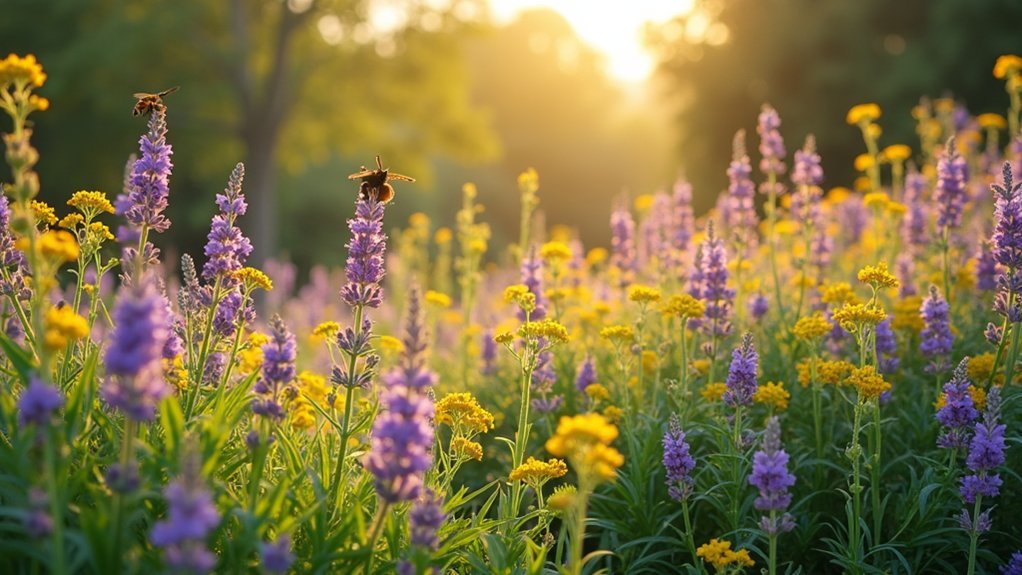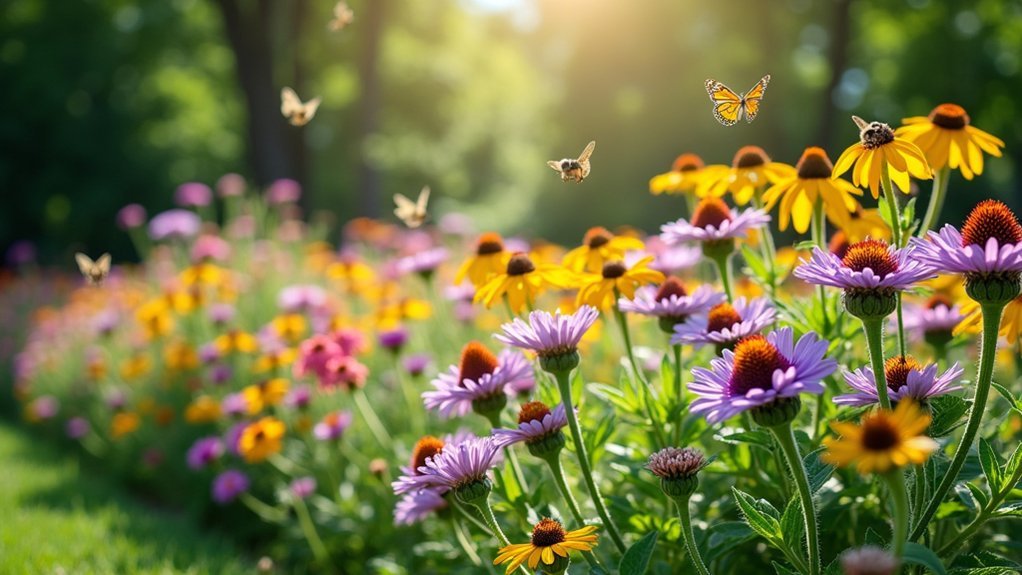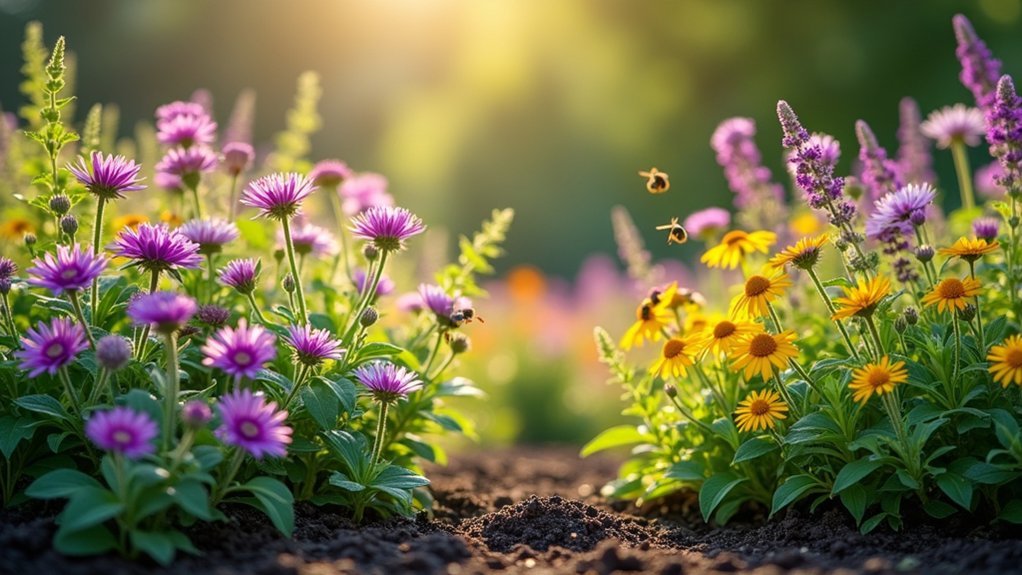Low-effort perimeter plants benefit pollinators while saving you time and energy. These native species create habitat, provide year-round nectar sources, and naturally suppress weeds. Even small plantings (30m²) greatly boost local bee populations and support monarch butterflies and other beneficial insects. You’ll enjoy vibrant blooms with minimal maintenance while creating essential ecological connections in your landscape. Discover how these boundary plantings can transform your property into a biodiversity hotspot with just a few strategic choices.
Benefits of Low-Maintenance Perimeter Plantings for Pollinators

While many gardeners hesitate to add more plantings to their landscape for fear of increased work, low-maintenance perimeter plantings offer remarkable ecological benefits with minimal effort.
By selecting native plants that naturally thrive in your local conditions, you’ll create habitat that supports diverse pollinator species without demanding constant attention.
Research shows that even small areas of about 30m² can considerably boost local bee populations. These low maintenance plantings enhance species richness by providing essential food sources and nesting sites for various beneficial insects.
Native wildflowers require minimal supplemental watering and adapt to different soil types, making them perfect for busy gardeners.
You’ll enjoy both the visual appeal of these plantings and the satisfaction of supporting ecological resilience in your garden—all while spending less time on upkeep.
Native Species That Thrive as Boundary Plants
Looking beyond the benefits of boundary plantings, let’s consider which native species work best along garden edges. You’ll find these pollinator-friendly options require minimal effort while maximizing biodiversity in your landscape.
| Native Species | Benefits to Your Garden |
|---|---|
| Varileaf Phacelia | Thrives in dry, rocky areas with minimal water needs |
| Black Eyed Susans | Attracts diverse bee species with vibrant blooms |
| Canada Goldenrod | Provides late-season nectar for migrating pollinators |
| California Poppy | Adds aesthetic appeal with drought-resistant qualities |
| Native Grasses | Creates shelter for beneficial insects year-round |
These garden plants adapt well to local soil conditions and climate challenges, eliminating the need for chemical inputs or excessive watering. You’ll enjoy their seasonal color while supporting vital pollinator populations with these resilient boundary choices.
Creating Year-Round Pollinator Support Along Property Lines

Your perimeter plantings can become biodiversity hotspots that support pollinators throughout their life cycles while defining your property’s edge with minimal maintenance.
By selecting native plants with staggered blooming periods—early spring bulbs, summer perennials, and late-season asters—you’ll create a continuous nectar buffet that sustains bees, butterflies, and other beneficial insects across seasons.
This seasonal succession not only guarantees year-round pollinator support but also adds visual interest to your boundary areas as different plants take center stage throughout the growing year.
Border Biodiversity Benefits
The strategic planting of native plants along property boundaries creates powerful ecological corridors that extend beyond aesthetic appeal.
Your perimeter planting area becomes a biodiversity hotspot, supporting complex ecosystems that might otherwise disappear from urban and suburban landscapes.
When you establish pollinator plant borders, you’re creating microhabitats that serve as refuge for beneficial insects and wildlife.
Research shows that even modest interventions of 30m² can greatly boost local bee populations.
These biodiversity zones act as stepping stones between larger natural areas, allowing species to move through fragmented landscapes.
The natural processes you allow—leaf litter, standing dead stems, and minimal intervention—create layered habitats supporting diverse life cycles.
Your property borders transform from simple boundaries to living systems that contribute meaningfully to conservation efforts with minimal maintenance requirements.
Seasonal Succession Strategies
Establishing a year-round pollinator support system requires thoughtful planning across seasons, not just sporadic bursts of bloom. By strategically selecting plant species that flower at different times, you’ll create a continuous food supply that supports pollinators throughout the year.
| Season | Plant Suggestions | Pollinator Activity | Maintenance Tips |
|---|---|---|---|
| Spring | Varileaf Phacelia | Emerging bumble bees | Minimal watering |
| Summer | Native sunflowers | Peak butterfly season | Group by water needs |
| Fall | Goldenrod, asters | Migration preparation | Allow seed heads to remain |
| Winter | Evergreen shrubs | Hibernation shelter | No pruning needed |
Native plants adapted to your local conditions require less effort while maximizing impact. When you combine early, mid, and late-seasonal bloomers along your property lines, you’ll foster ecological stability with minimal work—even small interventions considerably increase pollinator abundance in your landscape.
Design Principles for Natural Living Fences
Your living fence needs a layered habitat design with tall perennials in back, mid-height plants in the middle, and lower-growing species in front to create maximum biodiversity value.
Choose edge-defining native plants like switchgrass or little bluestem to clearly mark boundaries while providing essential pollinator resources throughout the seasons.
You’ll notice beautiful structural shifts as these plants evolve from spring growth to winter interest, maintaining habitat functionality even when dormant.
Layered Habitat Design
While planning your pollinator-friendly perimeter, consider the power of vertical space in layered habitat design. By combining different plant heights—ground covers, perennials, shrubs, and small trees—you’ll create a diverse ecosystem that attracts numerous pollinator species.
Start with native plants as your foundation; they’re adapted to local conditions and require minimal maintenance. Position taller species toward the back and shorter ones in front for maximum sunlight exposure.
Include flowering plants with sequential bloom times to provide continuous nectar sources throughout the growing season.
This thoughtful layering doesn’t just benefit pollinators—it creates a balanced ecosystem where beneficial insects help control pests naturally, reducing your need for chemical interventions.
Your layered habitat will serve as both food source and protective shelter, supporting pollinators through their entire life cycles.
Edge-Defining Native Plants
Natural living fences created from native plants offer far more ecological value than traditional barriers while defining your property’s edges with beauty and purpose.
By selecting a mix of native shrubs and perennials, you’ll create habitats that support local wildlife and enhance biodiversity throughout your landscape.
Edge-defining native plants require minimal maintenance once established, making them perfect for low-effort gardening.
Choose a variety of native flowering species that bloom in succession to provide continuous resources for pollinators from spring through fall.
These living boundaries don’t just attract butterflies and bees—they also prevent soil erosion and improve water retention along your property’s perimeter.
When you incorporate these ecological edges, you’re creating a resilient ecosystem that connects your garden to the broader environment while clearly defining your outdoor space.
Seasonal Structural Transitions
Designing effective living fences requires thoughtful consideration of seasonal structural shifts throughout the year. By incorporating plants that bloom sequentially, you’ll create a continuous resource for pollinators while maintaining visual interest in your landscape.
Low-maintenance perimeter plants that shift naturally through seasons offer multiple benefits:
- Year-round habitat – Different pollinator species need shelter during various life stages and weather conditions.
- Continuous food sources – Staggered blooming of native flowering plants guarantees nectar availability across seasons.
- Ecological resilience – Layered plant communities mimic natural ecosystems, improving soil health.
- Practical accessibility – Well-defined paths alongside seasonal shifts help you maintain and observe pollinator abundance.
Your living fence becomes not just a boundary, but a dynamic ecosystem that changes purposefully with the seasons.
Establishing and Maintaining Pollinator Corridors
Creating effective pollinator corridors doesn’t require extensive horticultural expertise—just thoughtful planning and native plant selection. Start by incorporating diverse native species that bloom sequentially throughout the growing season, ensuring continuous nourishment for bees, butterflies, and other pollinators.
Creating pollinator-friendly spaces requires only simple planning and native plants that flower throughout the season, not advanced gardening skills.
You’ll find that low-maintenance perimeter plants like native wildflowers and grasses naturally provide weed suppression while creating crucial pollinator habitats. Even a small 30m² area can greatly boost local bee populations.
Consider using biodegradable materials for additional weed control instead of chemicals that harm beneficial insects.
Don’t forget to include milkweed varieties—they’re essential for monarch butterflies and contribute to overall biodiversity.
With these strategic choices, your pollinator corridor will thrive with minimal intervention while creating meaningful ecological connections across your landscape.
Balancing Beauty and Biodiversity in Boundary Plantings

Boundary plantings offer a perfect opportunity to blend aesthetic appeal with ecological function when you select the right mix of native flowering plants. Your perimeter can simultaneously showcase visual charm while supporting vital pollinator populations.
- Layer strategically – Incorporate plants of varying heights to create dynamic visual interest while maximizing biodiversity potential in limited boundary spaces.
- Stagger bloom times – Select native plants that flower sequentially throughout the season to guarantee continuous nectar sources for pollinators.
- Embrace diversity – Mix different native plant species to attract a wider range of beneficial insects and birds, strengthening your garden’s ecosystem.
- Consider maintenance needs – Choose drought-tolerant native plants adapted to your local soil conditions to minimize watering and other maintenance tasks.
Frequently Asked Questions
How Do You Select Plants for Pollinators?
You’ll want to select native plants that bloom throughout the season, providing continuous food sources. Choose varieties with high pollinator visitation rates and match them to your garden’s specific soil, moisture, and sunlight conditions.
What Are the Benefits of Pollinator Friendly Plants?
Pollinator-friendly plants in your garden attract bees and butterflies, boost ecosystem health, support food production, conserve water, and require less maintenance. They’ll create a vibrant habitat while helping endangered pollinator species thrive.
What Plant Attracts the Most Pollinators?
Milkweed and lavender attract the most diverse pollinators. You’ll see bees, butterflies, and even hummingbirds flock to these plants. Native wildflowers like black-eyed Susans and asters are also exceptional pollinator magnets.
Why Do Pollinators Prefer Native Plants?
Pollinators prefer native plants because they’ve co-evolved together. You’ll find these plants offer better nutritional value in pollen and nectar, matching specific foraging needs that non-native species simply can’t provide for local pollinators.
In Summary
Your perimeter plantings can do double duty—define your property while supporting local pollinators with minimal effort. By choosing native species that thrive with little maintenance, you’re creating essential habitat and food sources year-round. These living boundaries connect fragmented ecosystems while adding natural beauty to your landscape. Start small, expand gradually, and you’ll enjoy both the ecological benefits and the colorful visitors these plantings attract.





Leave a Reply